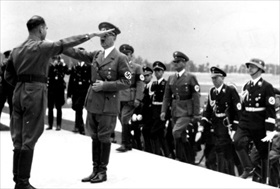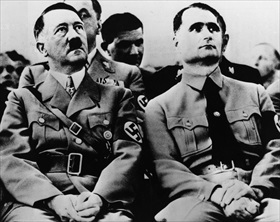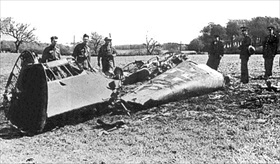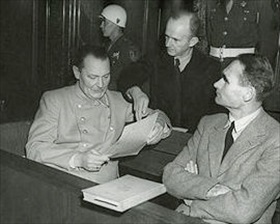HITLER FIXES DATE FOR BARBAROSSA
Berlin, Germany · May 12, 1941
On this date in 1941, two days after Deputy Reich Fuehrer Rudolf Hess had embarked on his historic “peace mission” to England, Adolf Hitler finally confirmed June 22 as the start date for Operation Barbarossa, the invasion of the Soviet Union. Among Hitler’s goals was the eradication of the “Jewish Bolshevik” regime along with its supposed underpinnings (i.e., the Jewish “race”), combined with the aim of gaining a huge area for living space (“Lebensraum”) in the East suitable for German (“Aryan”) colonization and for exploiting raw materials to sustain the war. The declaration of war, which Italian dictator Benito Mussolini and Hitler’s Axis military partner read before it was announced publicly and with which he was in complete agreement, was full of typically delusional Hitlerian rhetoric: it stated that Nazi-holdout England had already lost the war; like a drowning man fumbling for a branch to save himself, British “warmongers” sought to save themselves by grabbing hold of the Soviet Union. Defeating the Soviets in eight weeks would make Germany the unrivaled dominant power in Europe, dash British hopes for sustaining their war against Nazi Germany (England was an enemy Hitler did not want in the first place), and cause the United States to hesitate before entering the conflict on England’s side. Hitler thanked the Duce for his offer to dispatch an Italian expeditionary corps to the Eastern Front but saw no urgent need for additional men and arms. One month later, impatient to move off the sidelines and join Hitler in the war against Russia, Mussolini dispatched aircraft, cars, trucks, horses, and 62,000 men, the first of over 200,000 Italian servicemen to fight the Red Army. By the time war-weary Italians deposed Mussolini on July 25, 1943, 64,000 of their countrymen had been killed or wounded on the Eastern Front and another 54,000 would die in Soviet captivity. Worse yet, perhaps, was Hitler’s reaction to Italy’s announcement of an armistice with the Western powers on September 8–9 that year: 600,000 Italian soldiers, humiliated and disorganized in defeat and without orders, offered little resistance when a vengeful Wehrmacht gathered them up and delivered them as slave laborers to the German Reich later in month.
[amazon_carousel widget_type=”ASINList” width=”600″ height=”200″ title=”Recommended Reading” market_place=”US” shuffle_products=”False” show_border=”False” asin=”0752460706,1612000029,1782004084,0857454625,0700619089,1936274299,0521747171,0304358436,052117015X,0521747139″ /]
Rudolf Hess, Deputy Fuehrer to Adolf Hitler and Deputy Head of the Nazi Party, April 1933–May 1941
 |  |
Left: After hearing Adolf Hitler speak in a small Munich beer hall, Hess joined the Nazi Party on July 1, 1920, becoming the sixteenth member. After his first meeting with Hitler, Hess said he felt “as though overcome by a vision.” Hess was granted titles such as Reich Minister without Portfolio, member of the Secret Cabinet Council, and member of the Ministerial Council for Reich Defense. In 1939 Hess was even designated Hitler’s successor after Reich Marshal Hermann Goering.
![]()
Right: Once among Hitler’s constant companions until 1933, by the mid-1930s Hess was estranged from the Nazi center of power, viewed by many in Hitler’s inner sanctum as an eccentric loner with obscure interests. Hoping to regain importance and redeem himself in the eyes of his Fuehrer, Hess flew a German fighter plane alone to Scotland on a “peace” mission, May 10, 1941, just before Operation Barbarossa, the Nazi invasion of the Soviet Union. Recent evidence suggests Hitler was in the know regarding Hess’s effort to “neutralize” England prior to the invasion.
 |  |
Left: The wreckage of Hess’s Messerschmitt Bf 110 after crashing in Scotland on May 10, 1941. When Hitler met Mussolini in early June 1941, he teared up, confessing he had a “Hess problem.” Hitler and the Nazi propaganda mill went into a full court press, describing Hess as mentally ill. One theory is that Hitler was worried lest Hess spill the beans to the British about his impending liquidation of the Soviet Union, so the Nazis made every attempt to trash Hess’s image inside and outside Germany.
![]()
Right: Defendants former Reich Marshal Hermann Goering, former Kriegsmarine chief Adm. Karl Doenitz (dark suit), and former Deputy Fuehrer Rudolf Hess confer during the Nuremberg Trials, 1945–1946. Hess was found guilty of crimes against peace (planning and preparing a war of aggression) and conspiracy with other German leaders to commit crimes. He was handed a life sentence and incarcerated in Berlin’s Spandau Prison until his death, maybe by suicide, maybe not (see video), at age 93, in 1987.
Rudolf Hess: His Trial at Nuremberg and the Controversy Over His Death
![]()

 History buffs, there is good news! The Daily Chronicles of World War II is now available as an ebook for $4.99 on Amazon.com. Containing a year’s worth of dated entries from this website, the ebook brings the story of this tumultuous era to life in a compelling, authoritative, and succinct manner. Featuring inventive navigation aids, the ebook enables readers to instantly move forward or backward by month and date to different dated entries. Simple and elegant! Click
History buffs, there is good news! The Daily Chronicles of World War II is now available as an ebook for $4.99 on Amazon.com. Containing a year’s worth of dated entries from this website, the ebook brings the story of this tumultuous era to life in a compelling, authoritative, and succinct manner. Featuring inventive navigation aids, the ebook enables readers to instantly move forward or backward by month and date to different dated entries. Simple and elegant! Click 











